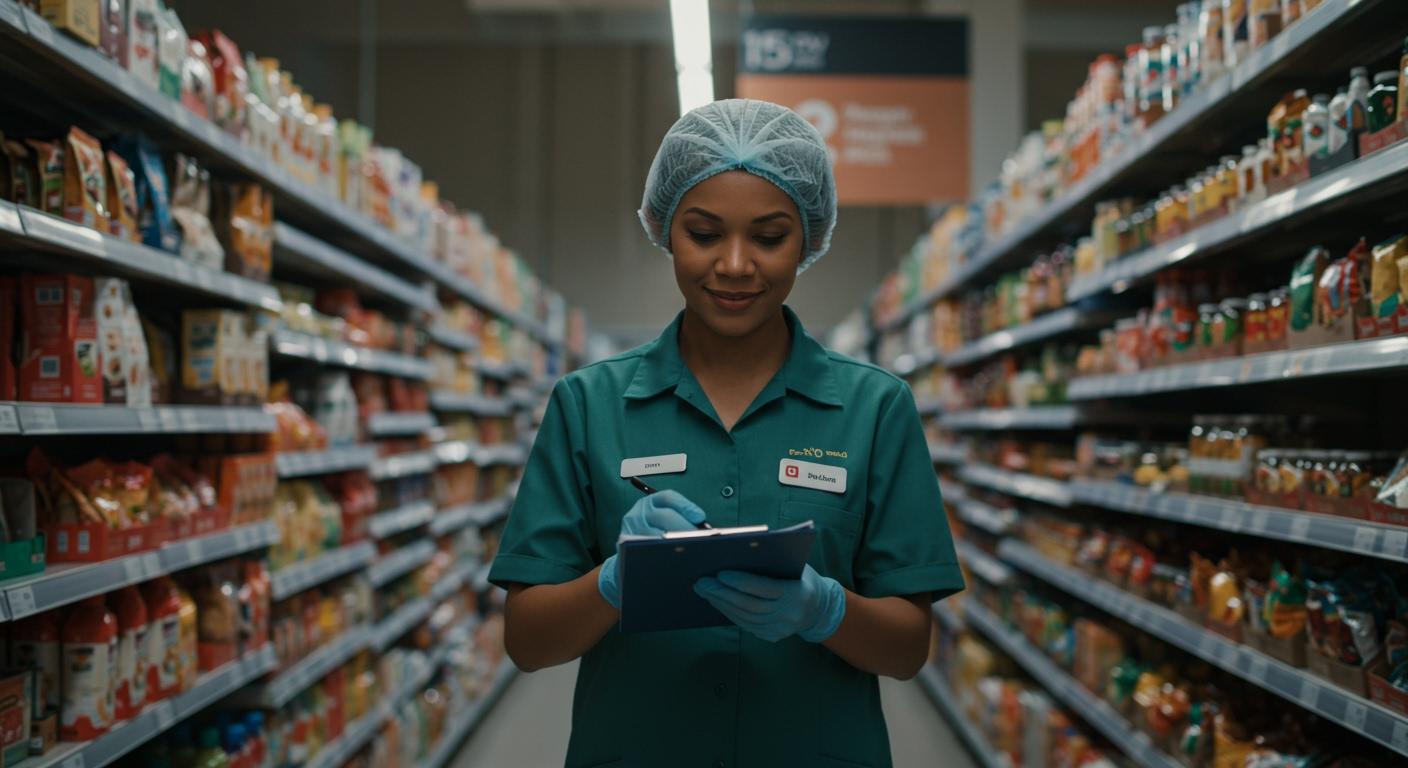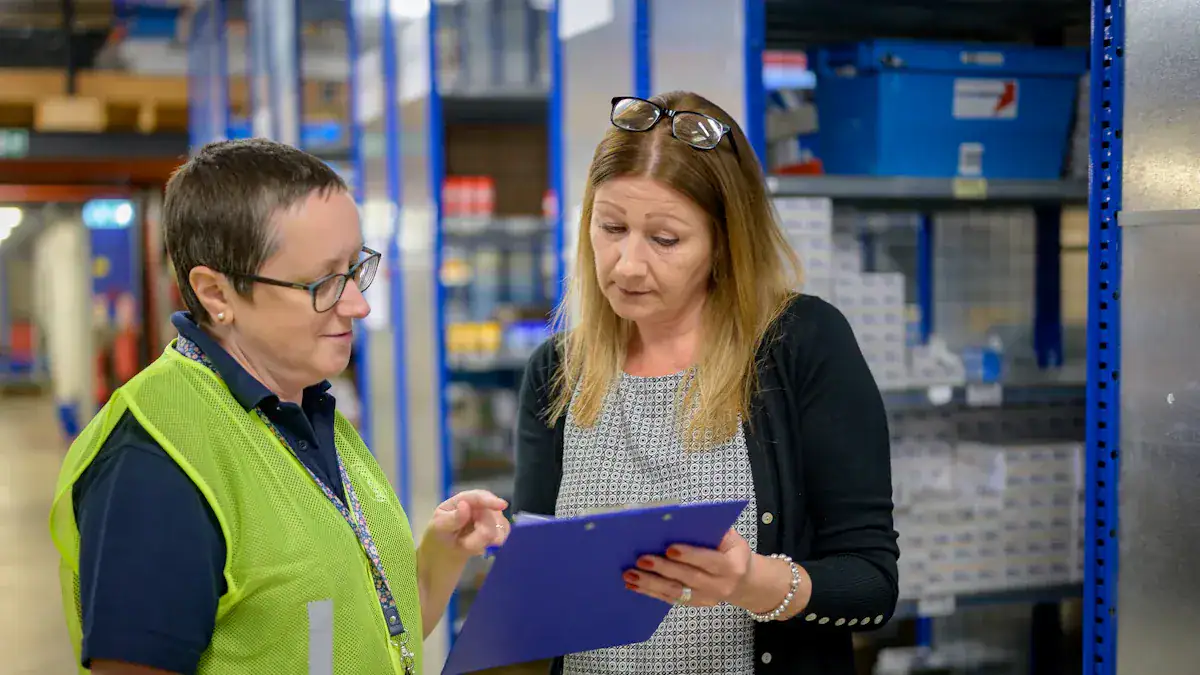How to Ensure Your Supermarket Uniforms Meet Safety Standards

Safety compliance matters when you choose supermarket uniforms for your team. You protect staff and customers from health hazards and workplace accidents. Non-compliance exposes your business to legal risks and damages your reputation. Proper uniforms boost professionalism and create a safer shopping environment. As you read, take a moment to review your current uniform practices and spot areas for improvement.
Key Takeaways
Ensure compliance with OSHA and local regulations to protect staff and avoid legal issues.
Follow strict food safety guidelines to prevent contamination and maintain a safe environment.
Choose durable fabrics for uniforms to reduce replacement costs and enhance professional appearance.
Prioritize comfort and fit in uniforms to support employee efficiency and reduce workplace injuries.
Select easy-cleaning materials to maintain hygiene and support food safety compliance.
Use color-coded uniforms to improve branding and help prevent cross-contamination in different departments.
Implement a uniform management system to track inventory and ensure compliance with safety standards.
Regularly train staff on uniform care and safety protocols to promote a culture of safety and professionalism.
Safety Standards for Supermarket Uniforms
OSHA and Local Rules
You must comply with Occupational Safety and Health Administration (OSHA) regulations when selecting retail uniforms for your team. OSHA sets standards to protect workers from hazards in the workplace. These rules cover everything from slip-resistant footwear to protective clothing for employees handling cleaning chemicals. Local and state authorities may also have specific requirements for grocery store uniforms. For example, some regions require closed-toe shoes or prohibit jewelry that could pose a safety risk. You should review both federal and local guidelines regularly to ensure your uniforms meet all legal obligations. This approach helps you avoid fines and keeps your staff safe on the job.
Food Safety Guidelines
Food safety remains a top priority in any supermarket environment. You need to follow strict guidelines to prevent contamination and protect both customers and staff. The dress code for grocery store uniforms serves several important purposes:
The uniform policy aims to prevent food contamination and maintain safety and brand standards.
Required attire often includes chef coats, specific shirt colors, and grooming rules such as hair covers.
Personal hygiene is essential. Employees should bathe and wash their hands before putting on clean uniforms.
You must ban clothing and accessories that create food safety hazards, such as torn garments and open-toe shoes.
Document your uniform policy, update it regularly, and include it in employee training.
By following these steps, you create a safer environment and reinforce your commitment to high-quality uniforms and food safety.
Tip: Regularly update your uniform policy and provide ongoing training to keep your team informed about the latest food safety standards.
Industry Best Practices
You can strengthen your safety program by adopting industry best practices for retail uniforms. Well-designed grocery store uniforms do more than meet minimum requirements—they set a higher standard for cleanliness and safety. The table below highlights some of the most widely recognized best practices:
Best Practice | Description |
|---|---|
Uniforms act as a barrier between employees and food, reducing the risk of contamination. | |
Strict Standards | Professionally laundered uniforms meet high industry standards for cleanliness and safety. |
Safety Features | Uniforms include design elements like snap buttons and closed seams to prevent contamination. |
You should choose grocery store uniforms that incorporate these features. Retail uniforms with safety-focused designs help protect your staff and customers while enhancing your store’s professional image. When you invest in high-quality uniforms, you demonstrate your commitment to safety and excellence.
Key Features of the Best Uniforms for Grocery Staff

Durability
When you select grocery store uniforms, durability should be your top priority. Uniforms that withstand daily wear and frequent washing help you maintain a professional appearance and reduce long-term costs. Materials like 65/35 poly-cotton blends and industrial-grade polyester offer stain-resistant finishes and can endure over 50 wash cycles. These fabrics also meet strict standards for seam strength, colorfastness, and pilling resistance. The table below highlights the most reliable materials and their durability features:
Material Type | Price Range | Durability Features |
|---|---|---|
65/35 poly-cotton blends | $5-8/piece | Stain-resistant finishes with 50+ wash cycles durability |
Industrial-grade polyester | $4-7/piece | Stain-resistant finishes with 50+ wash cycles durability |
You should also consider the technical requirements for durability:
Metric | Standard Requirement |
|---|---|
Seam strength | Minimum 25+ lbs tension resistance |
Colorfastness | 4+ rating after 50 industrial washes |
Pilling resistance | 3.5+ rating (ASTM D3512) |
Durable grocery store uniforms reduce replacement frequency, saving you money and supporting employee safety. Resilient uniforms also enhance your store’s professional image, which positively influences customer perception and boosts staff morale.
Tip: Prioritize durability in your uniform design to minimize replacement costs and maintain a consistent brand identity.
Comfort and Fit
Comfort and fit play a crucial role in the functionality of the best uniforms for grocery staff. When uniforms fit properly, your team can move freely and perform tasks efficiently. Ill-fitting uniforms may restrict movement and increase the risk of workplace injuries. You should always choose grocery store uniforms that offer a range of sizes and adjustable features. This approach ensures every employee feels comfortable and confident throughout their shift.
Employees who wear comfortable uniforms experience less fatigue and fewer distractions, allowing them to focus on customer service and daily operations.
Uniform design should balance comfort with safety requirements. Breathable fabrics and ergonomic cuts help your staff stay cool and productive, even during busy hours.
Easy Cleaning
Easy-cleaning features in grocery store uniforms are essential for maintaining hygiene and supporting food safety compliance. Uniforms that resist stains and wash easily help you prevent cross-contamination and keep contaminants away from food. You should select fabrics that meet HACCP and FSMA standards, ensuring rigorous cleaning processes. Professional uniform rental services can guarantee that uniforms remain consistently clean and compliant, reducing the risk of hygiene issues.
Description | Application in Supermarkets | |
|---|---|---|
Vacuum Sweepers | Efficiently removes dust and sand, suitable for various floor types. | Ideal for quick cleaning of high-traffic areas. |
Scrubber Dryers | Wet cleaning method for deeper dirt removal. | Best for maintaining hygiene on heavily soiled surfaces. |
Cleaning Robots | Automates cleaning tasks, saving time and labor. | Useful for large areas, can operate during off-peak hours. |
High-Pressure Cleaners | Effective for tough stains and deep cleaning. | Suitable for specific areas like the deli counter and bakery. |
Easy-cleaning uniforms help you maintain a professional appearance and support employee efficiency.
Consistently clean uniforms reinforce your commitment to food safety and brand identity.
Note: Choose stain-resistant fabrics and reliable cleaning technologies to ensure your supermarket uniforms always meet safety and hygiene standards.
Branding and Colors
You shape your store’s image every time you select supermarket uniforms. The right branding and color choices do more than create a cohesive look—they reinforce your brand identity and help customers recognize your staff instantly. When you choose colors that match your logo and store theme, you build trust and make your team stand out on the sales floor.
Color-coded uniforms also play a critical role in food safety and functionality. You can assign specific colors to different departments, such as blue for seafood, red for meat, and green for produce. This system acts as a visual indicator, making it easy to identify employees who work in high-risk areas. By doing so, you reduce the risk of cross-contamination. Staff and supervisors can quickly spot if someone enters the wrong area, which helps prevent the spread of pathogens.
Tip: Use color-coded uniforms to support both branding and food safety. This approach improves team organization and customer confidence.
When you invest in the best uniforms for grocery staff, you combine visual appeal with practical benefits. Consistent branding and smart color choices help you maintain a professional atmosphere and streamline daily operations.
Visibility and Safety
You must prioritize visibility and safety when selecting uniforms for your grocery staff. High-visibility clothing ensures that your employees remain safe in busy environments, especially in areas with heavy equipment or frequent customer traffic. Uniforms that meet EN ISO 20471 standards make your team easy to spot, which is essential for accident prevention.
Benefit of High-Visibility Uniforms | Description |
|---|---|
Workers stand out in crowded or low-light areas, reducing accident risks. | |
Compliance with Safety Standards | Meets EN ISO 20471 requirements for workplace safety. |
Faster Reaction Time | Drivers and equipment operators can see staff sooner and react appropriately. |
You protect your team by making them visible to both customers and machinery operators. This reduces the risk of accidents in high-traffic zones and during early morning or late evening shifts.
Enhanced visibility protects workers from hazards in busy areas.
High-visibility uniforms help workers stand out, reducing the risk of accidents from traffic or other hazards.
When you focus on visibility and safety, you create a secure environment for both staff and shoppers. You also show your commitment to employee well-being and operational excellence.
Role-Based Uniform Needs

Cashiers
Cashiers represent the front line of your supermarket. You want them to look professional and feel comfortable during long shifts. Uniform requirements for cashiers focus on safety, compliance, and brand consistency. Many companies set clear guidelines to ensure cashiers wear appropriate clothing and footwear. The table below outlines common standards from leading retailers:
Company | Clothing Requirements | Shoe Requirements | Safety Gear | Not Allowed |
|---|---|---|---|---|
Publix | Comfortable, durable clothing like t-shirts and jeans | Steel-toe or slip-resistant shoes may be required | High-visibility vests, gloves, and other protective equipment may be required | Open-toe shoes, loose clothing, and anything that could pose a safety risk |
Target | Solid red shirt with sleeves; Khaki or blue denim pants, skirts, shorts, or capris | Closed-toe shoes are required for safety | N/A | Shirts with large logos (unless Target-branded), ripped jeans, leggings, sweatpants, or clothing with offensive graphics |
You should select grocery store uniforms for cashiers that balance comfort and durability. Closed-toe, slip-resistant shoes help prevent workplace injuries. Avoid loose clothing and open-toe shoes, as these can create safety hazards at the checkout area. Consistent retail uniforms also help customers identify staff quickly, improving service and store security.
Tip: Provide clear uniform guidelines to new hires and reinforce them during regular training sessions.
Stockers
Stockers handle heavy lifting, restocking shelves, and moving inventory throughout the store. Their uniforms must support safety and flexibility. You should choose grocery store uniforms made from durable, breathable fabrics. These materials allow for a full range of motion and withstand frequent washing. High-visibility vests or accents help keep stockers safe in busy aisles, especially during early morning or overnight shifts.
Stockers benefit from retail uniforms with reinforced seams and pockets for tools. Slip-resistant, closed-toe shoes reduce the risk of slips and falls. You can further enhance safety by requiring gloves when handling heavy or sharp items. Uniforms that fit well and allow easy movement help stockers work efficiently and safely.
Deli and Bakery
Deli and bakery staff work in environments where food safety is critical. Their uniforms must meet strict health regulations and support sanitary practices. You should focus on the following safety features for deli and bakery uniforms:
Clean uniforms every shift to maintain a sanitary work environment.
Hair nets and gloves to prevent contamination.
Strong personal hygiene, including thorough handwashing before handling food.
Grocery store uniforms for deli and bakery staff should use light-colored, easy-to-clean fabrics. This makes it easier to spot stains or spills. Retail uniforms in these departments often include aprons and hats to further protect food from contamination. By enforcing these standards, you help ensure compliance with food safety laws and protect your customers.
Remember: Consistent uniform policies across all roles create a safer, more professional workplace.
Cleaning Staff
Cleaning staff play a vital role in maintaining a safe and hygienic supermarket environment. You need to equip your cleaning team with uniforms that meet strict safety and sanitation standards. These uniforms protect your staff from chemical exposure, reduce the risk of cross-contamination, and help customers identify cleaning personnel quickly.
Key Uniform Features for Cleaning Staff:
Chemical Resistance: Select uniforms made from fabrics that resist penetration by cleaning agents. This protects your staff from skin irritation and chemical burns.
Moisture Protection: Choose water-repellent materials. These fabrics prevent liquids from soaking through, keeping your team dry and comfortable.
High Visibility: Use bright colors or reflective strips. These features make cleaning staff easy to spot in busy aisles, reducing the risk of accidents.
Easy Removal: Opt for snap closures or breakaway designs. Quick removal helps staff respond to spills or chemical splashes without delay.
Personal Protective Equipment (PPE): Provide gloves, masks, and eye protection. These items shield your team from hazardous substances and airborne particles.
Uniform Feature | Purpose | Example Material/Design |
|---|---|---|
Chemical Resistance | Shields skin from harsh cleaning agents | Coated polyester, PVC |
Moisture Protection | Keeps staff dry during wet cleaning tasks | Water-repellent finishes |
High Visibility | Prevents collisions in crowded areas | Neon colors, reflective tape |
Easy Removal | Enables fast response to emergencies | Snap buttons, Velcro |
PPE Integration | Enhances overall safety | Built-in glove loops, mask pockets |
You should enforce strict laundering protocols for cleaning staff uniforms. Always wash these garments separately from other uniforms to prevent chemical residue transfer. Use industrial-grade detergents and high-temperature cycles to remove contaminants effectively.
Tip: Schedule regular uniform inspections for your cleaning team. Replace any garments that show signs of wear, fading, or chemical damage. This practice ensures ongoing protection and compliance.
Train your cleaning staff on the correct use and care of their uniforms. Demonstrate how to check for damage, wear PPE, and report uniform issues. When you invest in high-quality, safety-focused uniforms, you protect your team and maintain a clean, compliant store.
Cleaning staff uniforms do more than meet regulations. They signal your commitment to safety, hygiene, and professionalism. Customers notice when your cleaning team looks prepared and protected. This attention to detail builds trust and reinforces your supermarket’s reputation for excellence.
Choosing and Managing Grocery Store Uniforms
Fabric Selection
You need to select fabrics that balance safety, comfort, and durability for your grocery store uniforms. The right fabric keeps your staff comfortable during long shifts and helps maintain a professional appearance. When you choose materials, look for features that support both hygiene and performance.
Fabrics engineered for airflow and rapid evaporation keep employees cool in hot weather.
Activewear polos made from poly-spandex knit offer moisture-wicking properties and stretch, which improves comfort and flexibility.
Antimicrobial finishes help control odor, which is essential for maintaining professionalism throughout the day.
Durable and breathable fabrics reduce replacement costs and improve employee satisfaction.
The Aer Fabric combines lightweight durability with breathability, making it ideal for long shifts.
Stain resistance ensures uniforms look clean and presentable, even after busy days.
You should always prioritize uniform design that supports both safety and functionality. When you invest in high-quality fabrics, you protect your team and reinforce your store’s reputation for cleanliness.
Supplier Evaluation
Choosing the right supplier for your grocery store uniforms is a critical step. You want a partner who understands your industry’s safety standards and can deliver consistent quality. Start by researching suppliers with experience in retail and food service. Request samples to evaluate fabric quality, stitching, and overall construction.
Consider these factors when evaluating suppliers:
Ability to provide a range of sizes and styles.
Reliable delivery schedules and responsive customer service.
Transparent pricing and clear return policies.
Ask for references from other grocery stores or supermarkets. A reputable supplier will have a track record of meeting deadlines and maintaining high standards. You should also check if the supplier offers support for uniform management systems, which can streamline ordering and inventory.
Tip: Build a long-term relationship with your supplier to ensure consistent quality and quick resolution of any issues.
Customization Options
Customization enhances both branding and safety for your team. You can design custom apparel using templates or create uniforms from scratch. Adding your company logo to uniforms helps customers identify staff and strengthens your brand identity. You can also select styles and colors that align with your store’s branding guidelines.
Customization Feature | Description |
|---|---|
Design Custom Apparel | Create custom uniforms using templates or original designs. |
Add Logos | Place company logos on uniforms for clear staff identification. |
Select Styles and Colors | Choose options that match your branding and department needs. |
Customization also improves functionality. You can tailor uniforms to fit various body types and sizes, which enhances comfort and safety. Consider climate control features for employees working in refrigerated areas. Practical uniform design ensures your staff can perform their tasks efficiently every day.
Uniform Management Systems
Uniform management systems give you a powerful tool to keep your grocery store uniforms organized, compliant, and consistent. These systems use software or specialized services to track, distribute, and maintain uniforms for every staff member. You gain control over inventory, ordering, and compliance with safety standards.
A uniform management system helps you avoid common problems like missing garments, inconsistent branding, or non-compliant attire. You can assign uniforms to each employee, monitor their condition, and schedule replacements before issues arise. This proactive approach keeps your team looking professional and ensures everyone meets safety requirements.
Key Benefits of Uniform Management Systems:
Ensure all uniforms meet current safety regulations and company dress codes.
Streamline the ordering process, reducing errors and saving time.
Maintain consistent branding by controlling color, style, and logo placement.
Track inventory levels to prevent shortages or overstock.
Schedule regular laundering and replacements to keep uniforms clean and in good condition.
Tip: Use a uniform management system to automate reminders for laundering and replacement. This helps you maintain hygiene and compliance without extra effort.
You can choose from several types of uniform management solutions. Some stores use cloud-based software that integrates with payroll and HR systems. Others partner with uniform rental companies that handle cleaning, repairs, and replacements. Both options help you reduce administrative work and focus on store operations.
Feature | Benefit | Example Use Case |
|---|---|---|
Automated Ordering | Reduces manual errors | New hires receive correct uniforms |
Inventory Tracking | Prevents shortages and overstock | Alerts when stock runs low |
Compliance Monitoring | Ensures all uniforms meet safety standards | Flags outdated or non-compliant items |
Branding Control | Maintains consistent appearance | Updates logo or color store-wide |
Uniform management systems also support staff accountability. You can track which employee has each uniform and monitor returns or replacements. This reduces loss and helps you enforce uniform policies.
When you implement a uniform management system, you show your commitment to safety, professionalism, and efficiency. Your staff benefits from reliable, clean uniforms. Your customers notice the consistent, polished appearance. You protect your brand and maintain compliance with industry standards—all with less hassle.
Training and Uniform Care
Staff Training
You set the foundation for safety and professionalism when you train your team on proper uniform use. Effective training ensures everyone understands how to wear, care for, and maintain grocery store uniforms. You should tailor your training content to address the unique challenges your workplace faces. Customization increases engagement and helps your staff remember key points.
Training Method | Description |
|---|---|
Customization | Tailor content to address specific workplace challenges. |
Interactive Learning | Use hands-on activities to improve retention and application of knowledge. |
Scenario-Based Training | Simulate real-life situations to encourage active participation. |
You can boost learning by using interactive methods. Scenario-based simulations and quizzes help your team apply safety protocols in real situations. Breaking down complex information into smaller, manageable parts also aids understanding and memory. When you invest in quality training, you build a culture of safety and accountability.
Tip: Schedule refresher sessions regularly to reinforce best practices and update your team on any changes to uniform policies.
Laundering Procedures
Proper laundering procedures keep your grocery store uniforms clean and compliant with safety standards. You should provide clear instructions for washing and caring for uniforms. Always separate uniforms from personal clothing to prevent cross-contamination. Use industrial-grade detergents and high-temperature cycles to remove bacteria and stains.
Wash uniforms after every shift, especially for roles that handle food or chemicals.
Inspect garments for damage or excessive wear before laundering.
Store clean uniforms in a designated area to maintain hygiene.
You may choose to partner with a professional laundry service. This option ensures consistent cleaning and reduces the risk of hygiene issues. Clean uniforms not only protect your staff but also reassure your customers about your commitment to safety.
Replacement Schedules
You need a clear replacement schedule to maintain the integrity and appearance of your grocery store uniforms. Uniforms lose effectiveness as they wear out. Regular inspections help you spot signs of fading, tearing, or loss of protective features.
Replace uniforms immediately if you notice damage that could compromise safety.
Set a standard replacement interval, such as every six to twelve months, depending on usage and department.
Keep extra uniforms on hand to avoid shortages during busy periods or emergencies.
A proactive replacement plan ensures your team always looks professional and stays protected. You show your staff and customers that you value safety and high standards.
Ongoing Compliance and Review
Uniform Audits
You need to schedule regular uniform audits to maintain safety and compliance in your supermarket. Audits help you identify issues before they become problems. You can use a checklist to review the condition, cleanliness, and fit of retail uniforms. Inspect uniforms for signs of wear, fading, or damage. Check that all safety features, such as high-visibility strips or protective coatings, remain intact.
Inspect uniforms at least once every quarter.
Document findings and address any non-compliance immediately.
Replace uniforms that no longer meet safety standards.
Tip: Involve supervisors in the audit process. Their feedback can help you spot trends and prevent recurring issues.
A thorough audit process ensures your team always wears retail uniforms that meet both company and regulatory requirements.
Regulation Updates
You must stay informed about changes in safety regulations that affect retail uniforms. Laws and guidelines can change quickly. You should assign a team member to monitor updates from OSHA, local health departments, and industry associations. Subscribe to newsletters or alerts from regulatory bodies.
Source | What to Monitor |
|---|---|
OSHA | Workplace safety standards |
Local Health Dept. | Food safety and hygiene rules |
Industry Associations | Best practices and trends |
When you receive updates, review your uniform policies right away. Update your procedures and communicate changes to your staff. Quick action helps you avoid fines and keeps your store compliant.
Staff Feedback
You gain valuable insights when you listen to your staff about retail uniforms. Employees wear these uniforms every day. They notice comfort issues, safety concerns, and practical challenges. Set up a simple feedback system, such as suggestion boxes or digital surveys.
Ask staff about fit, comfort, and ease of cleaning.
Encourage them to report any safety hazards or uniform failures.
Review feedback during team meetings and use it to improve your uniform program.
Note: When you act on staff feedback, you show that you value their input. This builds trust and encourages a culture of safety.
Continuous feedback and review help you maintain high standards for retail uniforms. You create a safer, more comfortable workplace for everyone.
Uniform Policy and Implementation
Policy Guidelines
You set the foundation for safety and professionalism with clear uniform policy guidelines. Start by outlining the required attire for each role in your supermarket. Specify acceptable clothing, footwear, and accessories. Include hygiene standards and instructions for laundering. Define the process for requesting new uniforms or reporting issues. Use a single source of truth, such as a digital handbook, to centralize all uniform details. This approach reduces confusion and ensures every team member has access to the latest information.
A well-structured policy helps you promote brand consistency across all departments. When everyone follows the same guidelines, your store projects a unified image. This consistency strengthens your brand identity and builds trust with customers.
Tip: Review your policy regularly to keep up with changes in safety regulations or store operations.
Communication
You must communicate your uniform policy effectively to all staff. Begin with clear instructions during onboarding. Use visual aids, such as posters or digital guides, to reinforce expectations. Hold regular meetings to address questions and share updates. Issue precise guidelines for any changes, so employees know exactly what to do.
Create store profiles for each location. Tailor communication to address unique needs or challenges at different sites. This method ensures consistent messaging while allowing flexibility for local requirements. Encourage staff to ask questions and provide feedback. Open communication helps you catch misunderstandings early and keeps everyone aligned.
Communication Tool | Purpose | Example Use |
|---|---|---|
Posters | Visual reminders | Break rooms, lockers |
Digital Guides | Easy access to policies | Staff portal |
Meetings | Address questions, share updates | Monthly check-ins |
Enforcement
You enforce your uniform policy by combining proactive monitoring with supportive correction. Assign in-store teams to conduct spot checks, rather than relying only on managers. This approach speeds up issue resolution and empowers staff to take ownership. When you spot a compliance issue, escalate for correction and follow up to ensure it gets resolved quickly.
Maintain campaign visibility by using tracking tools. Monitor compliance in real time and address problems as soon as they arise. Establish a feedback loop with your team. Encourage employees to report concerns or suggest improvements. This ongoing dialogue helps you catch errors early and maintain high standards.
Follow these steps to enforce your policy effectively:
Escalate for correction when you find errors.
Use a centralized system for all uniform details.
Create digital store profiles for tailored messaging.
Issue clear, precise instructions for updates.
Gather real-time feedback from staff.
Empower teams to conduct spot checks.
Track compliance with digital tools.
Note: Consistent enforcement protects your staff, supports safety, and helps you promote brand consistency throughout your supermarket.
You ensure supermarket uniforms meet safety standards by following clear policies, choosing quality materials, and training your team. Regular audits and staff feedback help you maintain compliance.
Review your current uniforms for safety and comfort.
Consult industry experts if you need guidance.
Update your policies as regulations change.
Take action today. Proactive compliance protects your staff, strengthens your brand, and builds customer trust.
FAQ
What safety standards should supermarket uniforms meet?
You must follow OSHA guidelines, local health codes, and food safety regulations. Uniforms should protect staff from hazards and support hygiene. Always check for updates from regulatory agencies.
How often should you replace supermarket uniforms?
You should inspect uniforms regularly and replace them every six to twelve months. Replace immediately if you notice damage, fading, or loss of protective features.
Can you customize uniforms for different departments?
Yes. You can use color-coding, logos, and department-specific designs. Customization helps with staff identification and supports food safety by reducing cross-contamination risks.
What fabrics work best for grocery store uniforms?
Choose durable, breathable fabrics like poly-cotton blends or industrial polyester. These materials resist stains, support comfort, and withstand frequent washing.
How do you ensure uniforms stay clean and hygienic?
Wash uniforms after every shift using industrial-grade detergents. Store clean uniforms separately. You may use professional laundry services for consistent results.
Why is high-visibility clothing important for supermarket staff?
High-visibility uniforms help prevent accidents in busy areas. You make staff easy to spot for customers and equipment operators, which improves safety.
What should you do if staff report uniform discomfort?
Listen to feedback and review fit, fabric, and design. Adjust sizing or choose new materials if needed. Staff comfort supports safety and productivity.
Tip: Regularly collect staff feedback to improve uniform policies and maintain compliance.

